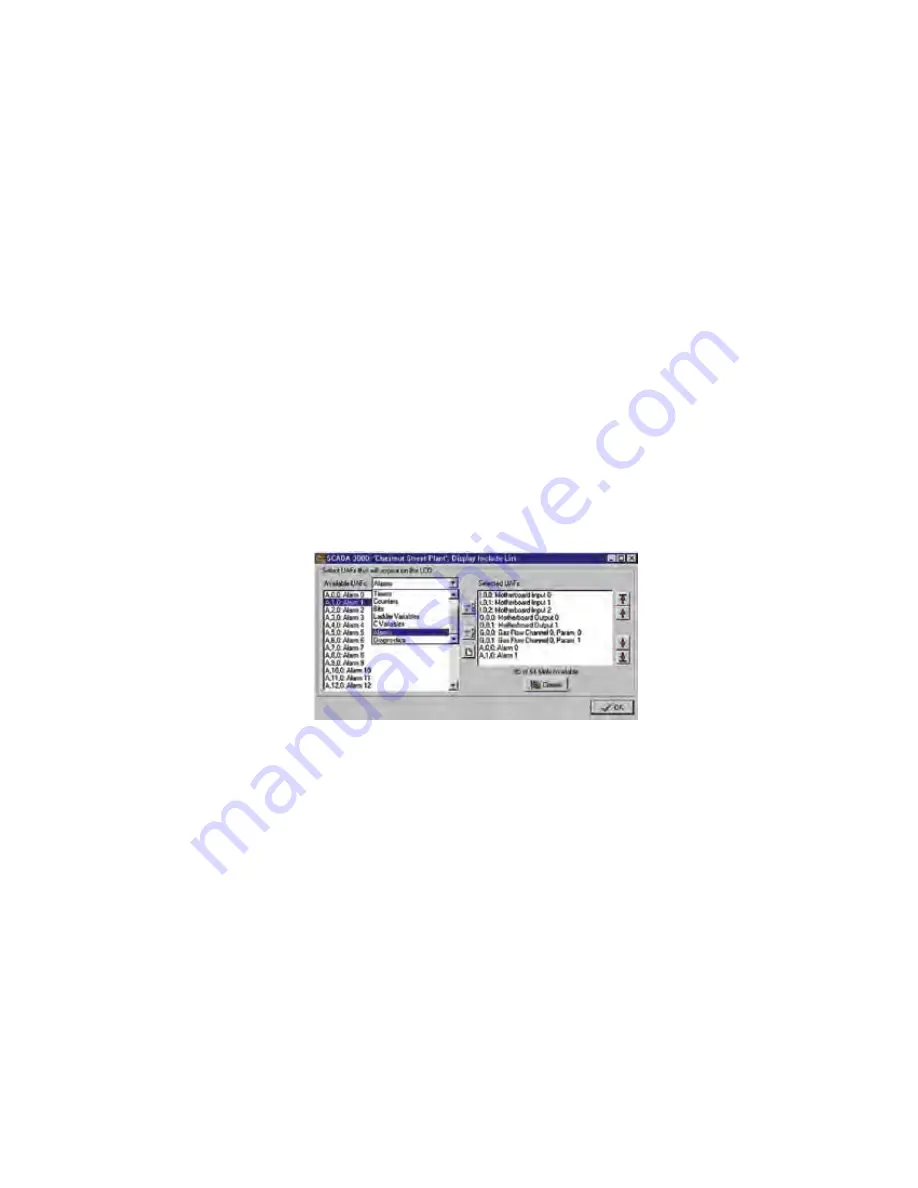
Chapter 13: LCD & KeYPAD PROGRAmmING
The SCADA 3000 includes a 4-line by 20-character liquid crystal display (LCD) and a
4-button keypad on its front panel. The display is used for viewing the values of data points,
checking system information, and acknowledging alarms. It has two modes of operation:
scrolling and manual. In scrolling mode the display will scroll through a programmable list
of data points, showing 4 at a time. Every 5 seconds it will change to display the next set of
points. You can customize the display to show only the points pertinent to your application.
The keypad is used to manually view specific information, acknowledge alarms and program
the data points that appear when the display is scrolling. You can also program the scrolling
data points from the SCADA 3000 software.
Display Backlight
An LED backlight is integrated into the display to allow viewing in dark environments. To
turn on the backlight, simply press one of the keypad buttons. The backlight will come on for
a few minutes, then shut off automatically to save energy.
DATA POINTS
Programming Data Points for Scroll mode
Click on the LCD button from the toolbar on the main programming form or select
Programming then LCD from the main menu. The following form should appear:
Figure 1: LCD Programming Form
This programming form is used to select the data points which will scroll on the LCD display.
The box on the left provides a list of all the data points that can be chosen for display. The
box on the right shows the data points that have been selected to appear on the display. In this
process you will be choosing items from the list on the left and copying them to the list on
the right. In the drop-down box next to the heading “Available UAFs,” choose the data point
category by clicking on the down arrow. The choices are:
Inputs, Outputs, Timers, Counters,
Bits, Ladder Variables, C Variables, Alarms,
and
Diagnostics.
When you pick a category a list of
all possible points in that category will appear. Click on the item you wish to add to the scroll-
ing display and then click on the
Add to List
button identified by the arrow pointing to the
right between the boxes. This will copy the highlighted item to the list of Selected Data Points
(“Selected UAFs”) on the right (i.e., those to appear on the LCD). Continue this process by
highlighting each data point on the left and copying it to the list of Selected Data Points on
the right. When you have finished making your list, click on the
Commit
button. This will
upload the list to the SCADA 3000 and it will immediately start displaying the programmed
data points on the display. Note that the unit defaults to having all of the main unit inputs and
outputs selected for display.
13-1
Summary of Contents for Sensaphone SCADA 3000
Page 1: ...Sensaphone SCADA 3000 User s Manual Version 2 34...
Page 6: ...vi SCADA 3000 User s Manual...
Page 10: ...x SCADA 3000 User s Manual...
Page 30: ...1 6 SCADA 3000 User s Manual...
Page 48: ...4 6 SCADA 3000 User s Manual...
Page 70: ...9 8 SCADA 3000 User s Manual...
Page 122: ...12 8 SCADA 3000 User s Manual...
Page 190: ...15 30 SCADA 3000 User s Manual...
Page 211: ...lead 1 lag 0 else lead 0 lag 1 16 21 Chapter 16 Programming in C...
Page 212: ...16 22 SCADA 3000 User s Manual...
Page 236: ...21 8 SCADA 3000 User s Manual...
Page 248: ...22 12 SCADA 3000 User s Manual...
Page 258: ...23 10 SCADA 3000 User s Manual...
Page 274: ...25 8 SCADA 3000 User s Manual...
Page 288: ...27 8 SCADA 3000 User s Manual...
Page 294: ...28 6 SCADA 3000 User s Manual...
Page 296: ...A 2 SCADA 3000 User s Manual...
Page 302: ...D 2 SCADA 3000 User s Manual...
Page 318: ...I 2 SCADA 3000 User s Manual...
Page 320: ...J 2 SCADA 3000 User s Manual...
Page 322: ...K 2 SCADA 3000 User s Manual...
Page 335: ...Test Log...
Page 336: ......






























